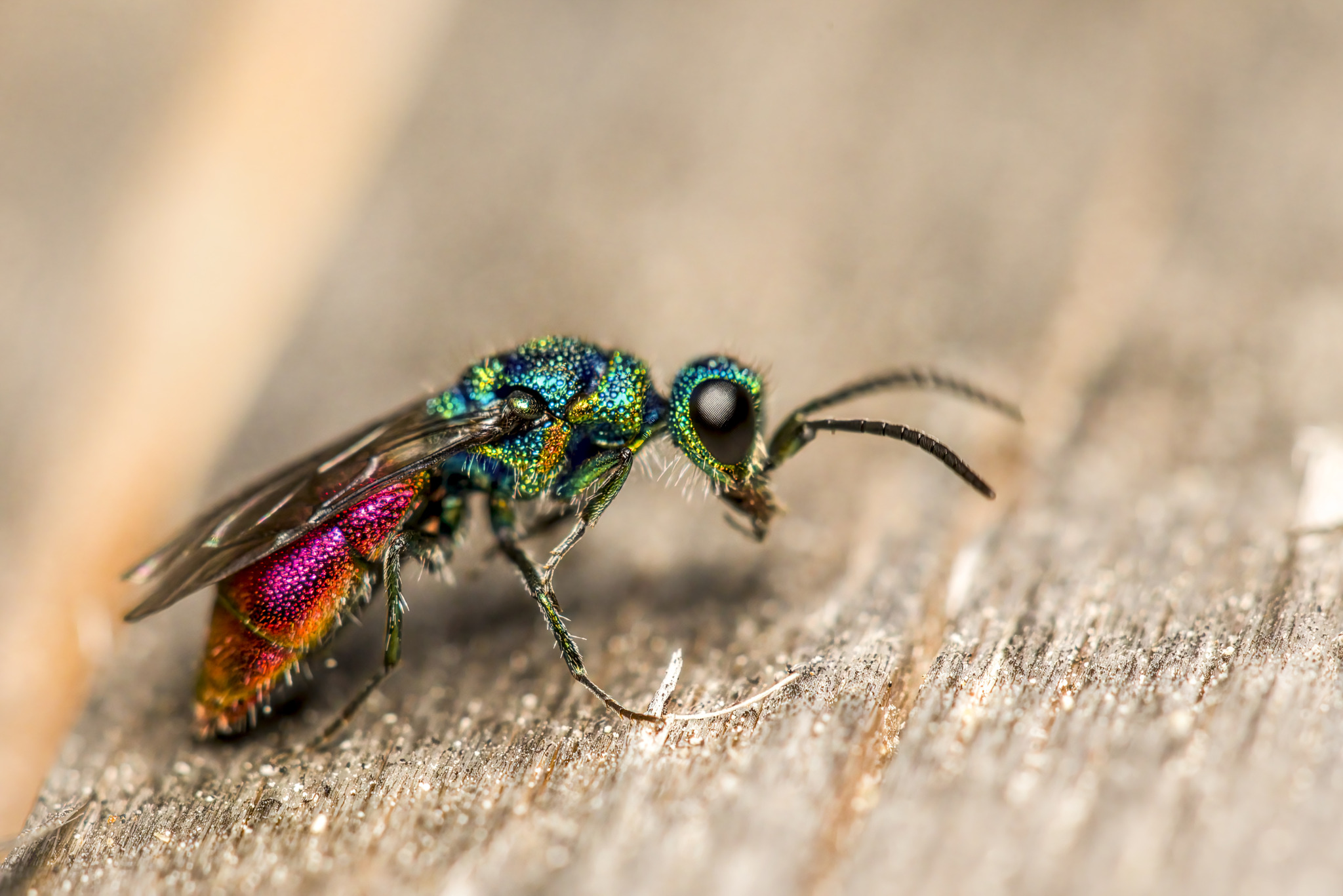Here’s a full overview of the stunning Ruby-tailed Wasp (Chrysis ignita complex) — one of the most brilliantly colored insects in Europe and a true jewel of the wasp world.
🐝 Ruby-tailed Wasp (Chrysis ignita complex)
Taxonomy
- Kingdom: Animalia
- Phylum: Arthropoda
- Class: Insecta
- Order: Hymenoptera
- Family: Chrysididae (Cuckoo Wasps)
- Genus: Chrysis
- Species group: Chrysis ignita complex
💡 The “Chrysis ignita complex” includes several nearly identical species that are difficult to separate without microscopy. Together, they’re commonly called Ruby-tailed Wasps.
Common Names
- Ruby-tailed Wasp
- Jewel Wasp
- Cuckoo Wasp
- Emerald Wasp (less commonly used)
General Description
Ruby-tailed Wasps are among the most dazzling metallic insects in the world, famous for their iridescent blue-green and red coloration. Their jewel-like exoskeleton refracts light, creating shimmering hues that change with viewing angle.
- Body length: 6–13 mm
- Coloration:
- Head and thorax: Metallic blue-green or turquoise
- Abdomen (tail): Bright ruby-red, copper, or magenta
- Texture: Densely pitted or sculptured surface, reflecting light in multiple directions
- Wings: Transparent with a slight smoky tint
- Behavioral trait: Can roll into a tight ball (thanatosis) when threatened — a defensive posture against ants or host wasps.
Distribution
Very widespread throughout the Palearctic region:
- Europe: From Scandinavia to the Mediterranean
- Asia: Across Russia, Central Asia, and into China and Japan
- North Africa: Present in temperate zones
Also introduced in some parts of North America.
Habitat
Prefers sunny, warm environments, especially those with dry sandy soil and exposed wood where solitary bees and wasps nest:
- Old wooden fences or beams
- Clay banks and sandpits
- Dead wood with insect holes
- Garden walls and stone structures
- Heathlands, meadows, and dunes
Behavior and Ecology
Ruby-tailed Wasps are cleptoparasites — they lay their eggs in the nests of other solitary wasps or bees.
When the Ruby-tailed Wasp larva hatches, it consumes the host egg or larva and then eats the stored food.
- Common hosts:
- Odynerus spp. (potter wasps)
- Eumenes spp.
- Osmia spp. (mason bees)
- Trypoxylon spp. (mud-dauber wasps)
- Adult diet:
- Adults do not sting and feed on nectar from umbellifers, wild carrot (Daucus carota), yarrow (Achillea millefolium), and other small flowers.
- Flight season:
- May to August (earlier in southern Europe).
Life Cycle
- Egg: Laid inside the nest cell of a host wasp or bee.
- Larva: Hatches and devours the host larva and its provisions.
- Pupa: Forms a hard cocoon, often overwintering inside the host nest.
- Adult: Emerges the following spring or summer.
Defense and Adaptations
- No functional sting.
- Armored exoskeleton: Very hard and sculptured, making it difficult for hosts to injure or remove them.
- Rolls into a ball (defensive posture): Protects vulnerable parts when attacked.
- Brilliant coloration: Possibly aposematic (warning) or camouflage through light reflection.
Conservation Status
- IUCN Red List: 🟩 Least Concern
- Status: Widespread and locally common.
- Sensitive to loss of traditional nesting habitats (old wood, sandy banks).
- Benefited by wildflower gardens, bee hotels, and natural deadwood structures.
Identification Notes
| Feature | Description |
|---|---|
| Color | Blue-green head/thorax, ruby-red abdomen |
| Length | 6–13 mm |
| Flight time | May–August |
| Hosts | Solitary bees and wasps |
| Behavior | Rolls into ball when threatened |
| Habitat | Sunny wood, sand, or stone with host nests |
Interesting Facts
- The iridescence comes from light interference in micro-layers of the cuticle, not from pigment — similar to how peacock feathers or butterfly wings shimmer.
- They are part of the Chrysididae, one of the most beautiful yet parasitic wasp families.
- The genus name Chrysis comes from Greek χρυσός (chrysos), meaning “gold”.
- Despite their metallic armor and wasp-like look, they are completely harmless to humans.
In Europe
- Common across southern and central Europe (e.g., Greece, Italy, France).
- In northern Europe (Estonia, Finland, Scandinavia), found in dry sunny slopes, dunes, and deadwood habitats during June–August.
- Especially abundant in nature reserves and wild gardens with solitary bees.
Would you like me to include a visual range and habitat map of the Ruby-tailed Wasp (Chrysis ignita) across Europe, or a comparison chart with similar metallic cuckoo wasps (Hedychrum, Chrysura, etc.)?
Views: 136
Subscribe to the newsletter:
